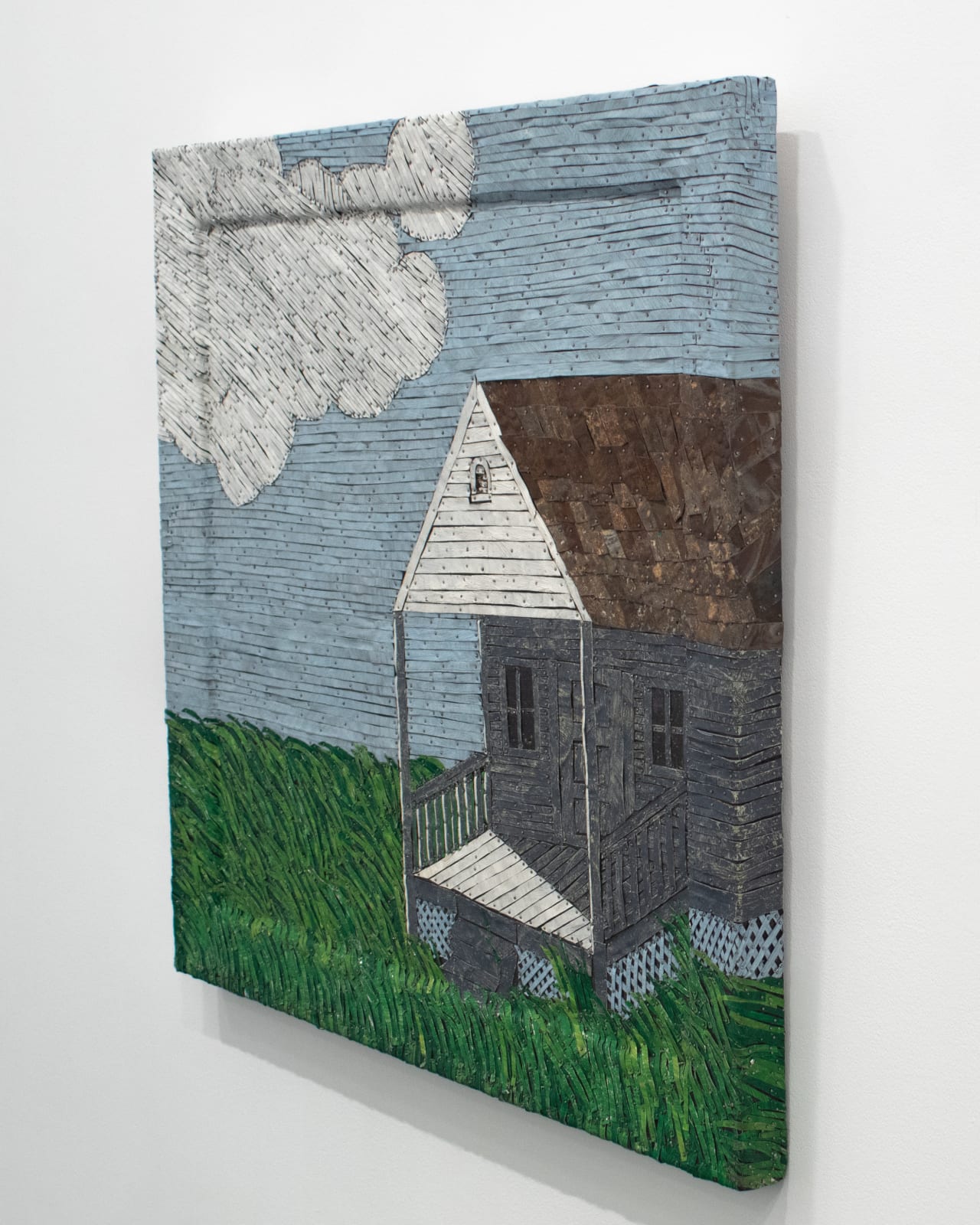ROBERT KOBAYASHI
Johnny Boy Lived There , 2010
Ceiling tin, paint, nails on wood
23 1/2 x 25 1/2 x 1 1/4 in.
Copyright The Estate of Robert Kobayashi
$ 45,000.00
Further images
It’s such a particular sight in Hawaii, this kind of structure. I remember my grandmother’s house being on stilts—a lot of houses in Hawaii are. The last house where my...
It’s such a particular sight in Hawaii, this kind of structure. I remember my grandmother’s house being on stilts—a lot of houses in Hawaii are. The last house where my parents lived was on a stilt-like foundation, and whatever was stored underneath the house was closed off by latticework doors padlocked together.
My father had a contentious relationship with his mother, and she died at age 97. When I was about six, I remember he hung up the phone after getting the call without emotion. My most vivid memories of her house look remarkably like Johnny Boy, even if I can only recall slivers of it: the tall white steps leading up to the front door, the long columns of the porch, the open gable of her roof, and the motif of latticework-enclosed crawl space. Dad added the tin roof because it was always his dream to have a wooden house in Hawaii with a tin roof, so he could listen to the rain. In his vision, the house is settled in the middle of a field, very different from the clusters of small houses down smaller streets that large families would share; his respite in the summertime from the commotion in his house was to sleep outside.
The setting feels like a blend of his work named after Ohio and its open skies. Dad’s landscape lacks the ever-present backdrop of the mountain ridge of Oahu, but it certainly captures its cloud formations. It feels like he was straddling two of his scenic daydreams at once: the sky vista of the Midwest and the architecture of his childhood—a bygone era of Hawaii that predated rampant tourism. The street he grew up on still exists, but it’s surrounded by a 4-lane highway and strip malls. High rises compete with the mountains, and Honolulu became, in his words, “a city of cranes.” I never considered what it must have felt like for him to watch this slow erosion of paradise into something else—a scramble to become a metropolis that the land itself seemed to deter by its unyielding nature. Roads don’t last long, and if the vines and trees aren’t trimmed, they will become consumed quickly by the forest.
The kinds of wooden houses that dad articulated in this piece are fragile and tough; they’re threatened by termites but can withstand brutal winds. However, they will eventually be lost to time. I never knew about my father’s desire to return home long before his illness; my mother unearthed a mockup of a house he wanted to eventually build in one of the valleys. It was long and open, plenty of space for visitors, and one huge stretch of tin for a roof.
- Misa Kobayashi
My father had a contentious relationship with his mother, and she died at age 97. When I was about six, I remember he hung up the phone after getting the call without emotion. My most vivid memories of her house look remarkably like Johnny Boy, even if I can only recall slivers of it: the tall white steps leading up to the front door, the long columns of the porch, the open gable of her roof, and the motif of latticework-enclosed crawl space. Dad added the tin roof because it was always his dream to have a wooden house in Hawaii with a tin roof, so he could listen to the rain. In his vision, the house is settled in the middle of a field, very different from the clusters of small houses down smaller streets that large families would share; his respite in the summertime from the commotion in his house was to sleep outside.
The setting feels like a blend of his work named after Ohio and its open skies. Dad’s landscape lacks the ever-present backdrop of the mountain ridge of Oahu, but it certainly captures its cloud formations. It feels like he was straddling two of his scenic daydreams at once: the sky vista of the Midwest and the architecture of his childhood—a bygone era of Hawaii that predated rampant tourism. The street he grew up on still exists, but it’s surrounded by a 4-lane highway and strip malls. High rises compete with the mountains, and Honolulu became, in his words, “a city of cranes.” I never considered what it must have felt like for him to watch this slow erosion of paradise into something else—a scramble to become a metropolis that the land itself seemed to deter by its unyielding nature. Roads don’t last long, and if the vines and trees aren’t trimmed, they will become consumed quickly by the forest.
The kinds of wooden houses that dad articulated in this piece are fragile and tough; they’re threatened by termites but can withstand brutal winds. However, they will eventually be lost to time. I never knew about my father’s desire to return home long before his illness; my mother unearthed a mockup of a house he wanted to eventually build in one of the valleys. It was long and open, plenty of space for visitors, and one huge stretch of tin for a roof.
- Misa Kobayashi









